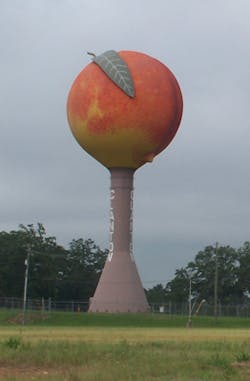PUMP GUY: Rocket Science
(a.k.a. "The Pump Guy")
As I write this article in my home office, I can hear the automatic dishwasher in the kitchen. The washer begins with a load of dirty dishes and ends with clean, dry plates ready to use again.
After a meal, you load the dirty dishes into the automatic washer, put the soap into the soap cup, close the cup door, close the main door, and push the “start” button. The process begins by water-blasting the plates. This rinses the crumbs, toothpicks, bones, gristle, gravy, seeds, paper napkins, and asparagus strings that no one eats. A special grinder pump pulverizes the waste into mush and flushes it.
When the rinse cycle completes, the soap cup opens and exposes the slow-dissolving soap. Another pump (that cannot be the grinder pump) sprays the soap and hot water onto the dishes at high pressure.
A thermostat detects the water temperature. If the water is not hot enough, the machine will re-heat the water to the proper temperature to cut grease and even more crumbs and left-over bits from the plates. The hot, soapy water flushes down the drain as the wash cycle ends.
When the wash cycle ends, another pump (that cannot be the soap pump or the grinder pump) rinses the plates to remove excess soap. Sometimes a few drops of special softening agent is mixed with the rinse water so water spots don’t appear on the plates, pots, and utensils as they dry.
As the rinse cycle ends, a heater and fan will blowdry the clean plates. Finally, a bell or buzzer will sound to alert the family that the plates are clean. I’m paying attention because it’s my turn to empty the washer and stow the dishes into the pantry, ready to use again.
With every new day there are increasingly automated processes in industry. There really is no reason a dairy or oil refinery can’t take the raw product (cow’s milk or crude oil) at the front end of the process plant, and turnout the finished product (coffee cream or jet fuel) at the back-end of the process with zero or minimal human intervention. Instrumentation is the key to process management.
The instrumentation technician is a better friend to the pump reliability engineer than the vibration analyzer or the CMMS program. I’ve written these words before in more than one “Pump Guy” article, but rarely does the instrumentation tech know the influence he exercises.
Pumps consume a large part of the daily maintenance budget. This is because most pumps are operated without adequate gauges, and rarely are the operators taught to interpret the gauges.
Let’s consider pumps and gauges. Pump manufacturers use the term “head” in feet or meters to express the energy or force in a liquid. Maintenance people use the term pressure in PSI for liquid force. The conversion factor 2.31 separates the two terms.
For water, head (in feet) divided by 2.31 is pressure. And pressure multiplied by 2.31 is head in feet. If the liquid is not ambient water, then the liquid’s specific gravity (sp.gr.) is factored into the math. This information is published in my CHEAT SHEETs (See: flwctrl.com/pg_cheatsheets).
[Head (ft.) / 2.31] x sp.gr. = PSI
[PSI x 2.31] / sp.gr. = Head in ft.
Here is an example:
Most communities have an elevated water tank that supplies water pressure to the neighborhoods below the tank. Let’s say that the level of water in the elevated tank is 173 ft. above the shower spray nozzle in the bathroom in one of the homes. What is the water pressure at the shower?
173 ft. / 2.31 = 75 PSI
There would be about 75 PSI of static water pressure at the shower nozzle because the water in the supply tank is 173 ft. above the shower nozzle. When someone opens the faucet and the water flows, there is a slight pressure drop at the nozzle due to friction losses in the pipes.
Let’s say that a pump is designed to develop 92 ft. of head. What does this mean? It means the pump can push a column of liquid up into the air 92 ft. above the liquid level in the origination vessel. It also means the pump can overcome 92 ft. of resistance in a pipe system. It also means the pump can develop 40 PSI of differential pressure.
92 ft. / 2.31 = 40 PSI
RELATED: 2.31 or .433?—The Numbers May Be Different, But the Result Is the Same
What does 40 PSI of differential pressure mean? This means if the suction pressure gauge reads 0 PSI, the discharge gauge would read 40 PSI (40 PSI diff.). If the suction gauge reads 55 PSI, the discharge gauge should read 95 PSI (40 PSI diff). The pump takes suction pressure, adds energy, and converts it to discharge pressure. This is also in the CHEAT SHEETS series of articles.
The pump operator knows that this pump is at its optimum design point when he sees 40 PSI of differential pressure across this pump. As the differential pressure moves away from 40 PSI (observed on the gauges), the maintenance rises on that pump. This is not a complicated concept.
If you walk around your plant and look at the pumps, you’ll see that most pumps don’t have pressure gauges on the suction nozzle. This means the operator has no reference point. (The discharge gauge reading means nothing without the suction gauge.)
You wouldn’t cook a pan of biscuits without a timer and temperature gauge on the oven. Why do you think a car’s dash instrument panel stares the driver (operator) in the face?
Why don’t the pumps have gauges? Some would blame the instrumentation tech, but instrumentation takes instructions from the production or process engineer. So why doesn’t the engineer order to install gauges on the pumps? Why does no one train the operators?
Mechanics and operators stand next to pumps without gauges every day. The operator has absolutely no idea if the pump is healthy or sick. Before long, the pump becomes a high maintenance pump.
And someone will say, “Maybe we should buy that $60,000 CMMS program.” And someone else will say, “Let’s buy that $80,000 vibration analyzer.” Well, the Pump Guy says, “Why don’t you go buy a set of gauges for $200 and train the operators to interpret the gauges?”
As a pump consultant, I see too many pumps without gauges. I see gauges where the needle has fallen off the stem. I see gauges with a fogged (or broken) cover glass; and this is a shame.
All pumps should have suction and discharge pressure gauges installed. The gauges should be calibrated, clean, and adequate for the service. Operators should monitor the differential pressure. The pump is sick if the differential pressure is too high or too low. This ain’t rocket science!
Tape this article to the stall door in the bathroom to ensure that your buddies will read it. Slide a copy under the engineer’s door.
I always spend time covering these points in the Pump Guy Seminar. Instrumentation technicians are vital to reliable pumps and reduced maintenance costs. For more details, see FlowControlNetwork.com/Pump Guy or contact Matt Migliore at 610 828-1711, [email protected].
Larry Bachus, founder of pump services firm Bachus Company Inc., is a regular contributor to Flow Control magazine. He is a pump consultant, lecturer, and inventor based in Nashville, Tenn. Mr. Bachus is a retired member of ASME and lectures in both English and Spanish. He can be reached at [email protected].





